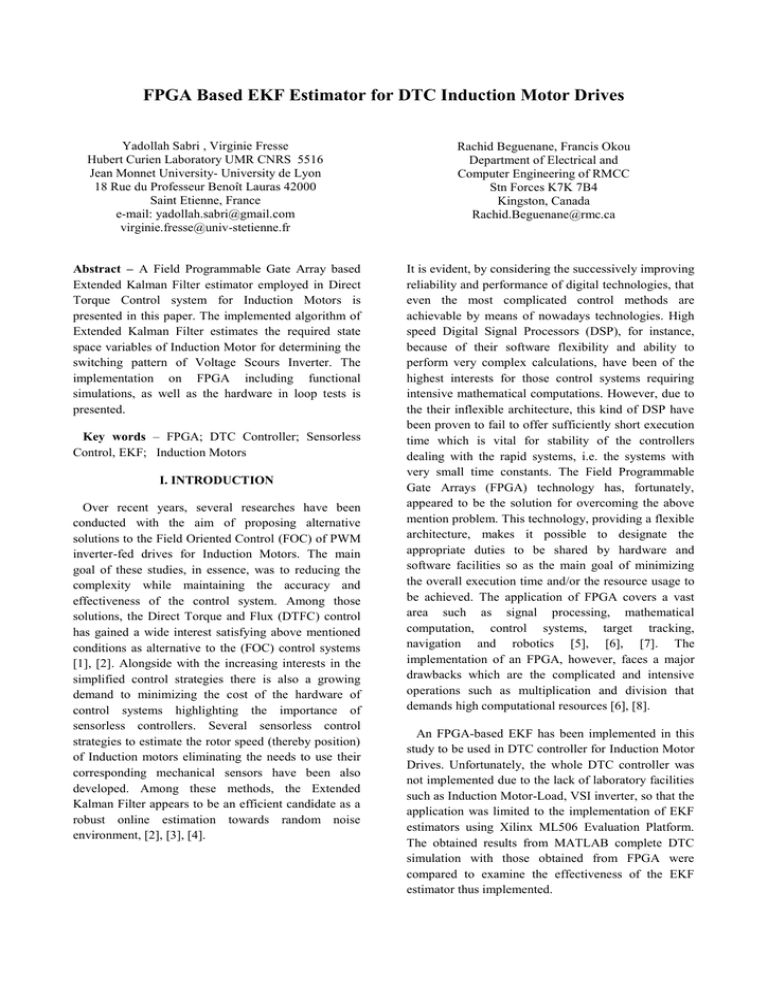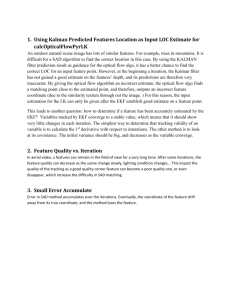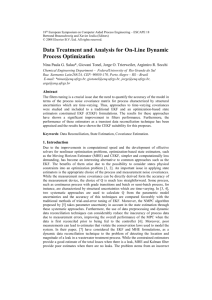FPGA Based EKF Estimator for DTC Induction Motor Drives
advertisement

FPGA Based EKF Estimator for DTC Induction Motor Drives Yadollah Sabri , Virginie Fresse Hubert Curien Laboratory UMR CNRS 5516 Jean Monnet University- University de Lyon 18 Rue du Professeur Benoît Lauras 42000 Saint Etienne, France e-mail: yadollah.sabri@gmail.com virginie.fresse@univ-stetienne.fr Abstract – A Field Programmable Gate Array based Extended Kalman Filter estimator employed in Direct Torque Control system for Induction Motors is presented in this paper. The implemented algorithm of Extended Kalman Filter estimates the required state space variables of Induction Motor for determining the switching pattern of Voltage Scours Inverter. The implementation on FPGA including functional simulations, as well as the hardware in loop tests is presented. Key words – FPGA; DTC Controller; Sensorless Control, EKF; Induction Motors I. INTRODUCTION Over recent years, several researches have been conducted with the aim of proposing alternative solutions to the Field Oriented Control (FOC) of PWM inverter-fed drives for Induction Motors. The main goal of these studies, in essence, was to reducing the complexity while maintaining the accuracy and effectiveness of the control system. Among those solutions, the Direct Torque and Flux (DTFC) control has gained a wide interest satisfying above mentioned conditions as alternative to the (FOC) control systems [1], [2]. Alongside with the increasing interests in the simplified control strategies there is also a growing demand to minimizing the cost of the hardware of control systems highlighting the importance of sensorless controllers. Several sensorless control strategies to estimate the rotor speed (thereby position) of Induction motors eliminating the needs to use their corresponding mechanical sensors have been also developed. Among these methods, the Extended Kalman Filter appears to be an efficient candidate as a robust online estimation towards random noise environment, [2], [3], [4]. Rachid Beguenane, Francis Okou Department of Electrical and Computer Engineering of RMCC Stn Forces K7K 7B4 Kingston, Canada Rachid.Beguenane@rmc.ca It is evident, by considering the successively improving reliability and performance of digital technologies, that even the most complicated control methods are achievable by means of nowadays technologies. High email :Rachid.Beguenane@rmc.ca speed Digital Signal Processors (DSP), for instance, because of their software flexibility and ability to perform very complex calculations, have been of the highest interests for those control systems requiring intensive mathematical computations. However, due to the their inflexible architecture, this kind of DSP have been proven to fail to offer sufficiently short execution time which is vital for stability of the controllers dealing with the rapid systems, i.e. the systems with very small time constants. The Field Programmable Gate Arrays (FPGA) technology has, fortunately, appeared to be the solution for overcoming the above mention problem. This technology, providing a flexible architecture, makes it possible to designate the appropriate duties to be shared by hardware and software facilities so as the main goal of minimizing the overall execution time and/or the resource usage to be achieved. The application of FPGA covers a vast area such as signal processing, mathematical computation, control systems, target tracking, navigation and robotics [5], [6], [7]. The implementation of an FPGA, however, faces a major drawbacks which are the complicated and intensive operations such as multiplication and division that demands high computational resources [6], [8]. An FPGA-based EKF has been implemented in this study to be used in DTC controller for Induction Motor Drives. Unfortunately, the whole DTC controller was not implemented due to the lack of laboratory facilities such as Induction Motor-Load, VSI inverter, so that the application was limited to the implementation of EKF estimators using Xilinx ML506 Evaluation Platform. The obtained results from MATLAB complete DTC simulation with those obtained from FPGA were compared to examine the effectiveness of the EKF estimator thus implemented. Over subsequent sections, the description of the Extended Kalman Filter will be presented including the main features of DTC controller, this section will be followed by description of EKF algorithm refinement and simulations. The development of the FPGA-based EKF algorithm will be then explained providing the results of the Hardware in Loop. The time/ area performance of implemented EKF will be discussed at the final section of this paper. II . DESCRPTION OF THE EXTENDED KALMAN FILTER (EKF) A. The state space model of induction motor and description of DTC control system The space state model of induction motor can be written as: . x f ( x, u ) w y Cx v (1) Where, x [is , is , r , r ] U [Vs ,Vs ]T , y [is , is ]T MRr M r 1 (1 Ts )is Ts L 2 k r Ts L k r Ts k Vs r r (1 T )i T M r T MRr T 1 V s s s r s r s s 2 Lr k k Lr k f ( x, u ) T M Ts is (1 s ) r Ts r r Tr Tr Ts M Ts is Ts r r (1 ) r T T r r same performance as provided by vector controllers [3]. Therefore, the advantages accrued to this control strategy as mentioned above have still maintained it in the top spot of interests for industry sector. The DTC control strategy, however, relies heavily upon the precise measurement or estimation of electromagnetic flux and torque as these two variables determine the switching pattern to be followed by VSI inverter. The importance of the electric flux and torque estimation reveals the necessity of using an identification algorithm to achieve the goal of DTC control strategy. The estimation or identification method employs the Extended Kalman Filter (EKF) in this study, so the subsequent part describes the main features of EKF. B . Overview of EKF algorithm The Kalman filter is a well-known recursive algorithm which takes the stochastic state space model of the system with together measured outputs to achieve the optimal state estimation of the system under consideration [2], [3]. The goal of Kalman filter, as it is outlined below, is to obtain the variables which are not measurable, i.e. covariance matrices Q, R and P of the system and measurement noise vectors and state vectors (x), respectively. The filter estimation ( x ) is obtained from the predicted values of the states (x) and this is corrected recursively by means of correction factor as the product of the Kalman gain (L) and the deviation of estimate and the actual output vector as ( y-C x ). xk / k -1 z x k 1 / k 1 x k 1 / k 1 C 0 0 0 0 1 0 0 0 R R M2 M ,k , s r2 0 Ls Lr Ls Lr Ls W and V in Equation (1) are the model and measurement disturbances which are statically described by the zero-mean Gaussian noises and characterized by covariance matrices Q and R as it will be illustrated in more detail through subsequent part B. uk+1 z-1 Prediction EKF Compensator Innovation kk+1 yk+1 i s i s r r r Figure 1, Systolic of the EKF algorithm The Direct Torque Control (DTC) strategy, in essence, utilizes a specific switching pattern introduced by Takashi and Noguchi [3] with the aim of achieving an effective exploitation of the full capacity of induction machines of producing electromagnetic torque and flux. Unlike the vector control systems, the DTC is the simplest in structure as it eliminates the need of using external current loop, while it attains the The system and measurement noise covariance denoted as Q and R, are 5 5 and 2 2 diagonal matrices, respectively. As previously stated, the state vector to be estimated is x [is , is , r , r , r ] and the estimation procedure of Kalman filter is performed over following steps as illustrated in block diagram form in figure 1. SwitchingL UT Sabc VSI INVERTER IM 1) Prediction of the state vector: The s , e , e prediction of state vector at sampling time of (k+1) from the input vector U(k) and state vector at previous sampling time (k) is given as: i s , i s ,r ,r , r x(k 1 / k ) f ( x(k / k ), U (k )) abc (2) vs , vs is , is EKF 2) Prediction covariance computation: The prediction covariance matrix is updated by: Figure 2, Block diagram of DTC control system p( k 1 / k ) F ( k ) p( k / k ) F ( k ) Q T (3) Where, Q is the covariance matrix of the system noise with F given as: F (k ) F X x [is , is , r , r , r ] was examined. (4) x ( k ) x ( k / k ) 3) Kalman gain computation: The Kalman filter gain or correction matrix is computed as: L(k 1) p(k 1/ k )C(k )T (C(k ) P(k 1)C(k )T R)1 (5) The prediction covariance matrix is then updated in terms of Kalman filter gain as: p(k 1/ k 1) p(k 1/ k ) L(k 1)C(k ) p(k 1/ k ) (6) 4) State vector estimation or innovation step: The predicted state-vector x (k+1/k) is added to the term referred to as innovation multiplied by Kalman gain to provide the overall state estimation vector x (k+1/k+1) as: The block diagram of DTC controller, as shown in figure 2, is simulated using MATLAB SIMULINK environment thereby the performance of simulated EKF block on estimating the state variables vector x(k 1/ k 1) x(k 1/ k ) L(k 1)( y(k 1) C x(k 1/ k )) (7) III. Algorithm refinement and fixed-point simulation Prior to dealing with implementation of the FPGAbased EKF algorithm the complete DTC controller was first simulated in order to evaluating the functionality of the whole control system. EKF algorithm has been fulfilled in a sequential procedure as summarized in section II (B). Clk Start en IV. Development of the FPGA-based EKF algorithm The EKF as described in section III (B) is an algorithm requiring a huge number of matrix calculations such as multiplication, division and addition. Due to such inevitably intensive matrix treatments, the FPGA architecture needs a special care regarding the optimization of consumed hardware resources without admitting any degradation of timing performances. The FPGA architecture of EKF compensator module is presented in figure 4 where the computation of covariance matrix P(k+1/k+1) and the optimal Kalman gain L(k+1/k+1) required for innovation step is illustrated. The whole matrix multiplication, as shown in figure 4, was achieved using a single [m n l ] pipelined multiplier where m, n M n l done m n l matrix multiplier en Figure 3, Actual and estimated state space variables: a) Isa, b) Isb, c) Phira, d) Wr Figure 3 summarizes the comparison between actual and estimated state space vector obtained from simulated Induction Motor and EKF blocks, respectively. By examining figures 3 (a) through (d), it can be seen that the proper convergence between actual and estimated variables was obtained. Moreover, a refinement of the EKF algorithm, to be implemented, was achieved so as the appropriate sampling period of 30 S satisfying the control system stability, as well as an optimal format of 25-bit fixed-point data is determined. Kalman gain control unit Addr_a A: En_a pk+1/k + R pk/k done Addr_b m n matrix - En_a En_b En_inv B: n l matrix En_b + - matrix inversion En_inv S-1 pk+1/k+1 Lk+1 Figure 4, FPGA- based architecture of the EKF compensator A. Hardware-in-loop (HIL) tests: Figure 5 describes the hardware in loop setup for FPGA-based EKF estimator. The designed and developed architecture was implemented in Xilinx FPGA VIRTEX-5 ML506 Evaluation Platform device using the RTL Precision Synthesis Tool and Xilinx ISE 10.1 [9]. Xilinx ML506 FPGA Evaluation Platform and l are the dimensions of two [m n] and [n l ] Figure 5, Hardware in Loop matrices to be multiplied at each step. The maximum value for m, n and l was 5 corresponding to the step when two F(k) and P(k/k) matrices with dimensions of [5 5] were supposed to be multiplied. It should be In the proposed setup, the observed or probed signals were the MATLAB output stator voltage and currents, and the output or control signals are the estimated state mentioned that, due to the dependency of the each step to its precedent operation, unfortunately in case of using one single multiplier, there was no possibility to achieve the concurrent operations. Therefore, the whole variables x [is , is , r , r , r ] . Figure 6 summarizes the comparisons between the results obtained from FPGA and those from MATLAB simulation model as described in previous sections. By examining the results shown in figure 6 (a) through (d), it is easy to notice that the results obtained from MATLAB SIMULINK and FPGA are in proper convergence as both have used the same fixed-point data format of 25-bit. The maximum error between the corresponding results was less than 2% which was due to the truncation occurred on multiplier operand being treated by 25×18 embedded pipelined multiplier of ML506 Evaluation Platform [9]. (a) B. Timing diagram of the DTC controller and time/area performances: The complete DTC controller was simulated using MATLAB SIMULINK environment with the sampling period Ts of 30µS. At each sampling moment the MATLAB SIMULINK model updated the electrical quantities of simulated Induction Motor so as the FPGA board started performing the Kalman gain computation process using the latest data provided by MATALB. The EKF architecture was synchronized using 32 MHz clock signal so as the whole EKF algorithm was performed in 18.61 µS. After performing each Kalman gain calculation procedure, the FPGA stopped its operation and waited for the next incoming start signal produced by MATLAB. Figure 7 describes the EKF timing diagram where the execution time for each step of EKF is shown. The prediction, Kalman gain calculation and innovation times are 1.1 µS, 16.99 µS and 1.61 µS, respectively. The whole EKF execution time is 62% the sampling period of 30 µS. (b) tEKF tpred tinov tgain kTs (c) (k+1)Ts Figure 7, EKF timing diagram It is worthwhile to mention that the whole EKF algorithm has used only 10% of FPGA resources. Table 1 summarizes the total resources usage of FPGA by EKF in more detail. Table 1, FPGA resources usage Available Used Utilization slice registers 32640 41 1% Slice LUTs 32640 195 1% Logics 32640 195 1% 25×18 Hw multipliers 136 9 7% (d) Figure 6, HIL results, a) Isa, b) Isb, c) Phira, d) Wr V. CONCLUSION The design and implementation of the FPGA-based Extended Kalman Filter estimator was presented in this paper. The implemented EKF algorithm as a part of DTC control system was described focusing on the FPGA architecture. Simulation and hardware in loop (HIL) results were provided in order to validate the performance and effectiveness of the developed design and the time/area analysis was then presented. The later proves that the employment of FPGA as a hardware solution improves considerably the execution time regarding with DSP-based software solutions. [4] S. Belkacem, F. Naceri and R. Abdessemend, EKF-based speed sensorless direct torque control of Induction Motor drives, Asian Journal of Information Technology 6(2): 185-191, 2007 By comparing the dimensions of the P and Q covariance matrices of [5×5] and corresponding total execution time of developed EKF algorithm of 18.61µS with those presented in [5] as [4×4] and 10.25µS, respectively; it is evident that the developed algorithm in this study is as effective as that one developed in [5]. [6] A. Bigdeli, M. Biglari-Abhari, Z. Salic, Y. T. Lai, A new Pipelined Systolic Array-Based Architecture for Matrix Inversion in FPGA with Kalman Filter Case Study, EURASIP Journal on Applied Signal Processing Vol. 2006 As stated previously, due to the lack of laboratory facilities, the authors have just implemented the EKF estimator where the rest of the whole DTC controller was simulated in MATLAB SIMULINK environment. However, an examination of time/ area performance of FPGA architecture reveals that the whole DTC controller is implementable using one single stand alone Xilinx ML506 FPGA Platform as the total recourses used for implementing EKF algorithm is only 10% of available FPGA hardware. The rest of the resource is quite enough to implement all low speed adders or multipliers required for designing the remaining parts of complete DTC controller. ACKNOWLEDGEMENTS This work is granted by the Rhone Alpes Region, SEMBA projet, Cluster ISLE, France. REFERENCES [1] G. Bottiglieri, G. Scelba, Sensorless speed estimationin induction motor drives, IEEE. Elec. Mac. IEMDC, pp. 624-630, 2003 [2] M. Barut, O. S. Bogosyan and M. Gokasan, An EKF based reduced order estimator for the sensorless control of IMs, Control Applications. CCA Proceedings of IEEE Conference , pp. 1256-1261, 2003 [3] M. Barut, O. S. Bogosyan and M. Gokasan, EKF based sensorless direct torque control of IMs in the low speed range, IEEE Trans. Indus. Elec. ISIE, pp. 696974, 2005. [5] L. Idkhajine, E. Monmasson, A. Maalouf, FPGAbased Sensorless controller for Synchronous Machine using an Extended Kalman Filter. Power Electronics and Applications. EPE 09. 13th European Conference on, Barcelona, 2009 [7] I. Bahri, M-W. Naouar, E. Monmasson, I. SalmaBelkhodja, L. Charaabi, Design of an FPGA-based real-time simulator for electrical system, Power Electronics and Motion Control Conference; EPEPEMC September 2008 [8] S. Bologani, M. Zigliotto, M. Zordan, EXtendedRange PSM Sensorless Speed Drive Based on Stochatic Filtering, IEEE Trans. On Industrial Electronics, Vol. 16, No 1, January 2001 [9] Xilinx Data Book, [Online], Available on: www.xilinx.com


